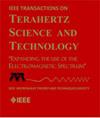嵌入微流控通道的太赫兹超材料传感器,用于实时检测液体分析物
IF 3.9
2区 工程技术
Q2 ENGINEERING, ELECTRICAL & ELECTRONIC
IEEE Transactions on Terahertz Science and Technology
Pub Date : 2025-03-07
DOI:10.1109/TTHZ.2025.3548847
引用次数: 0
摘要
许多生物大分子的振动和旋转能级落在太赫兹(THz)范围内,使太赫兹光谱学成为鉴定生物样品的可行方法。然而,大多数生物分子活动只能在液体环境中观察到。作为一种极性物质,水对太赫兹波具有很强的吸收特性。在这项研究中,我们提出了一种新型的太赫兹超材料传感器,该传感器在PDMS衬底上嵌入微流体通道,并在反射模式下工作。该方法不仅可以通过减小液体样品的体积来减少水对太赫兹波的吸收,而且可以实现对液体样品的实时检测。仿真结果表明,双裂环谐振器(DSRRs)金属结构在1太赫兹以下有两个谐振凹陷,最大优值为0.77 RIU-1。同时,随着微通道中分析物折射率的变化,传感器显示出明显的谐振频率红移。此外,还制作了双间隙裂环谐振器(SRRsTG)和双间隙裂环谐振器传感器,并利用太赫兹时域光谱系统进行了验证。当微通道为空(空气)时,实验结果与仿真结果吻合较好。该传感器能够通过观察两个谐振频率在不同电场极化下的位移和振幅变化来区分各种液体分析物(例如,水,丙酮和酒精)。此外,与SRRsTG传感器相比,DSRRs传感器显示出更高的灵敏度,对于酒精(99.7%)检测,在TE模式下频率位移高达92.1 GHz,在TM模式下频率位移高达192.3 GHz。该方法很容易通过标准光刻方法实现,并且可以应用于其他超材料结构以及生物样品的检测。本文章由计算机程序翻译,如有差异,请以英文原文为准。
Terahertz Metamaterial Sensor With Embedded Microfluidic Channels for Real-Time Liquid Analytes Sensing
The vibrational and rotational energy levels of numerous biological macromolecules fall within the terahertz (THz) range, making THz spectroscopy a viable method for identifying biological samples. However, most biomolecular activities can only be observed in a liquid environment. Being a polar substance, water exhibits strong absorption characteristics toward THz waves. In this study, we proposed a novel THz metamaterial sensor with embedded microfluidic channels fabricated in the PDMS substrate that operates in reflective modes. This approach not only enables the reduction of THz wave absorptions by water by decreasing the volume of the liquid sample but also realizes the real-time detection of liquid samples. Simulated results reveal that the double splits ring resonators (DSRRs) metal structure exhibits two resonant dips below 1 THz, with a maximum figure of merit of 0.77 RIU-1. Meanwhile, the sensors show significant resonant frequencies red-shifts as the refractive index for the analytes varies in the microchannels. Moreover, the split ring resonators with two gaps (SRRsTG) and DSRRs sensors were fabricated and demonstrated using a THz time-domain spectroscopy system. It has been found that the experimental results are in good agreement with the simulation results when the microchannels are empty (air). The sensors are capable of distinguishing various liquid analytes (e.g., water, acetone, and alcohol) by observing the shifts and amplitude variations for two resonant frequencies under different electric field polarizations. In addition, the DSRRs sensors show higher sensitivities in comparison to those of SRRsTG sensors, giving frequency shifts up to 92.1 GHz in TE mode and 192.3 GHz in TM mode for alcohol (99.7%) detections. The presented approach has been easily realized by standard lithography methods and could be applied to other metamaterial structures, as well as for biological sample detections.
求助全文
通过发布文献求助,成功后即可免费获取论文全文。
去求助
来源期刊

IEEE Transactions on Terahertz Science and Technology
ENGINEERING, ELECTRICAL & ELECTRONIC-OPTICS
CiteScore
7.10
自引率
9.40%
发文量
102
期刊介绍:
IEEE Transactions on Terahertz Science and Technology focuses on original research on Terahertz theory, techniques, and applications as they relate to components, devices, circuits, and systems involving the generation, transmission, and detection of Terahertz waves.
 求助内容:
求助内容: 应助结果提醒方式:
应助结果提醒方式:


